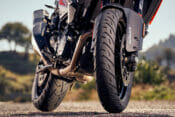The Ducati Panigale V4 S has been updated for the third time in four years. Has Ducati finally cracked the V4 jigsaw?
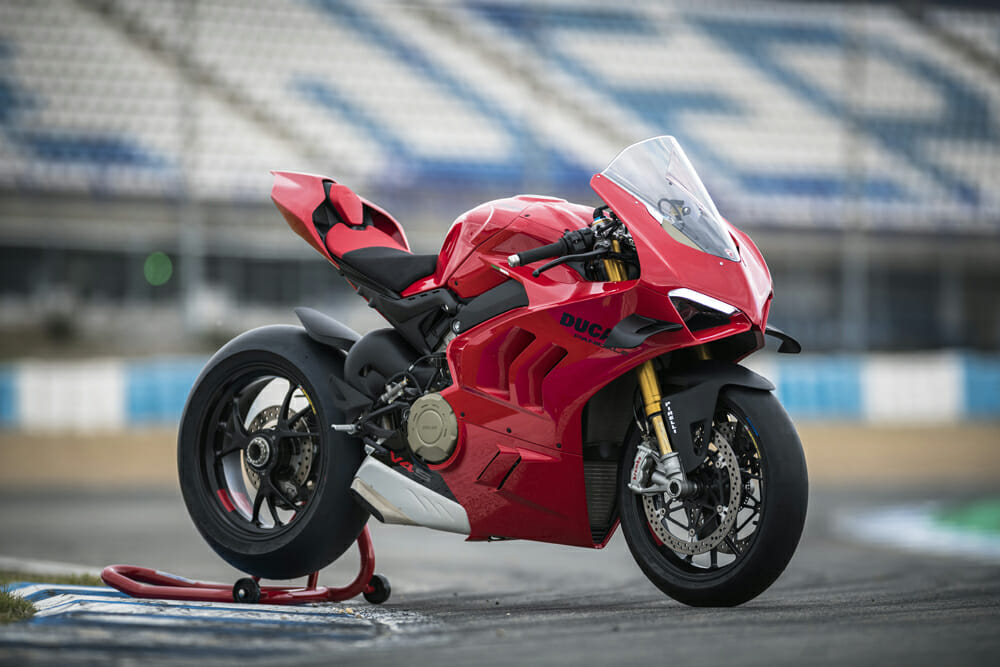
By Rich Taylor | Photography by Milagro
It feels like only yesterday we were out in Bahrain riding the last update to Ducati’s Panigale V4, and yet here we are writing about yet another update less than two years on.
Once the Ducati World Premiere teaser-taglines were released, the fifth episode titled Evolution of Speed seemed rather obvious. Or so we all thought, because it turns out it led a few of us a little astray. Surely, it’d be a new V4 R. Not so, it’s a new S (and the standard model, too).
Our minds raced. More wings? More power? Anyone would conclude it needs none of any of that, so what could the nutters from Bologna have in store so soon after the last one? As it transpires, it’s some of everything, and as always, the devil is in the detail.
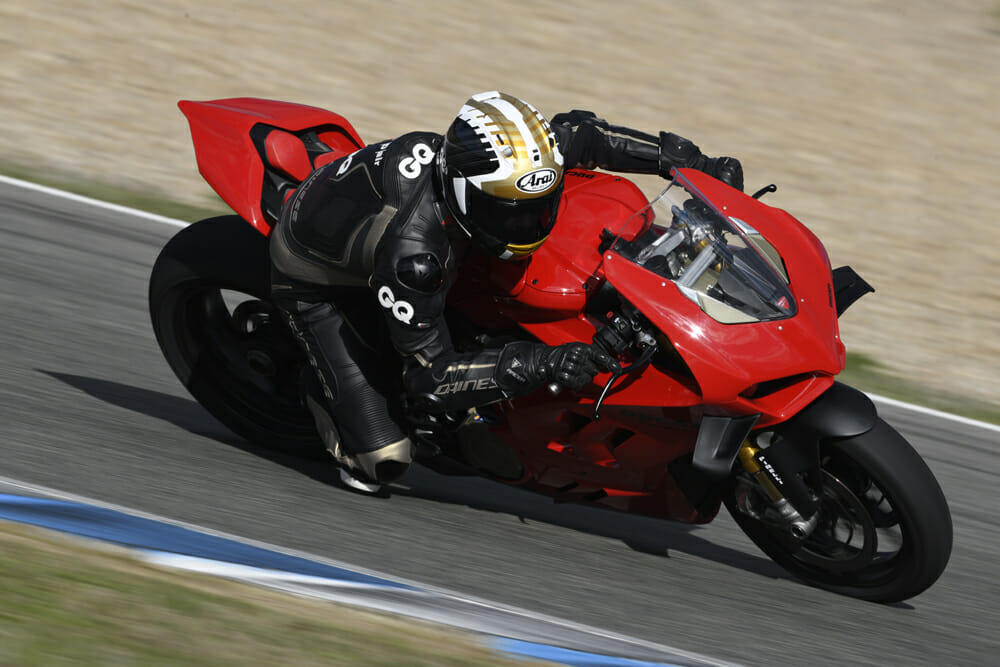
2022 Ducati Panigale V4 S Review | More of Everything
It goes like this. In true Ducati fashion, power is indeed up, although only marginally by 1.5 horsepower to 215.5—but ours in the U.S., thanks to our regulations, make 210 horsepower. Torque is quoted at 92.1 lb-ft at 9500 rpm, and it weighs in at a claimed 431 pounds dry.
The electronics package now sports its biggest upgrade ever with a load of new modes and torque maps for each individual gear. Speaking of the gearbox, that’s all-new, too, with revised, closer ratios coming directly from the WorldSBK paddock, which also gives the already excellent quickshifter an easier time of it all.
The forks, too, are new—still the same electronic Öhlins units in principle but now with more travel and a gas charge in each fork-lower. Chassis geometry and the swingarm pivot have been fettled to give better mid-corner feeling and support, and the wings are now smaller and more efficient, delivering the exact same downforce as those on the outgoing model. Overall, the brief was strikingly similar to many of the other bikes Ducati has updated and created in its lineup recently: to be faster and easier to ride.
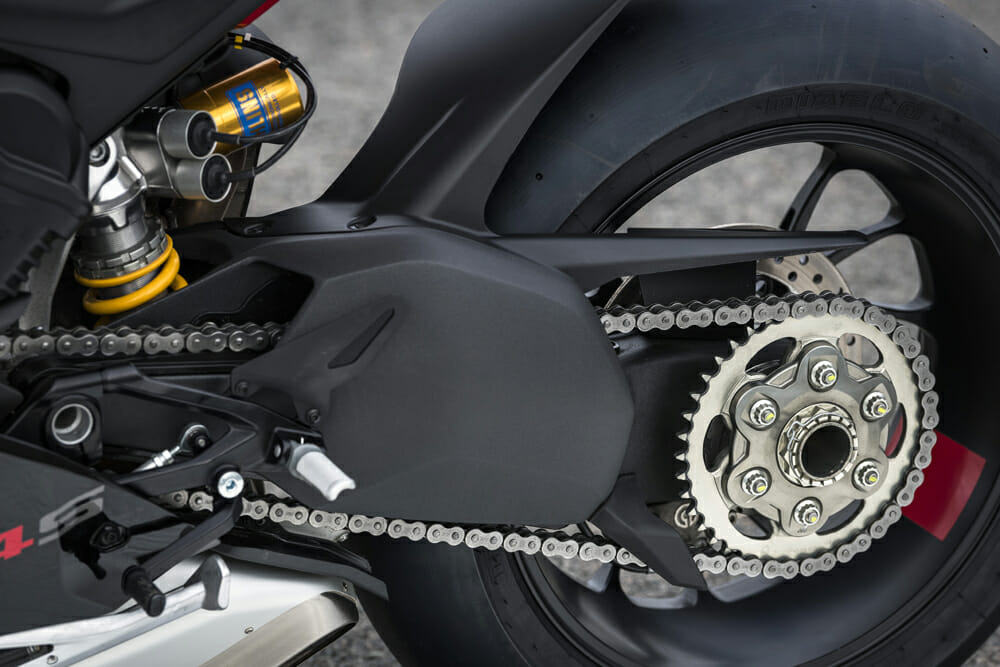
You might’ve also noticed some other changes. The S model sports a somewhat opinion-dividing two-tone seat unit, a red bum-stop and a blacked-out piece of fairing near the footpegs. This is how the S is delineated from the standard model, which receives none of the aforementioned features. Both models, however, receive blacked-out footpegs and updated Ducati graphics.
We half expected the exhaust cowling to be painted black, like the Panigale V2, however, it remains silver. The even more eagle-eyed among you will spot a narrower, reshaped tank which handily increases the tank capacity to 4.5 gallons and also provides some other benefits that we’ll touch on later. Under the fairings, there’s oil cooler and exhaust improvements, and on the surface there’s more gills for improved cooling.
The S model will set you back $29,995 and the standard model is $23,295; the difference mainly being suspension (electronic Öhlins vs. conventional Sachs), wheels (magnesium vs. cast alloy) and battery (li-ion vs lead acid).
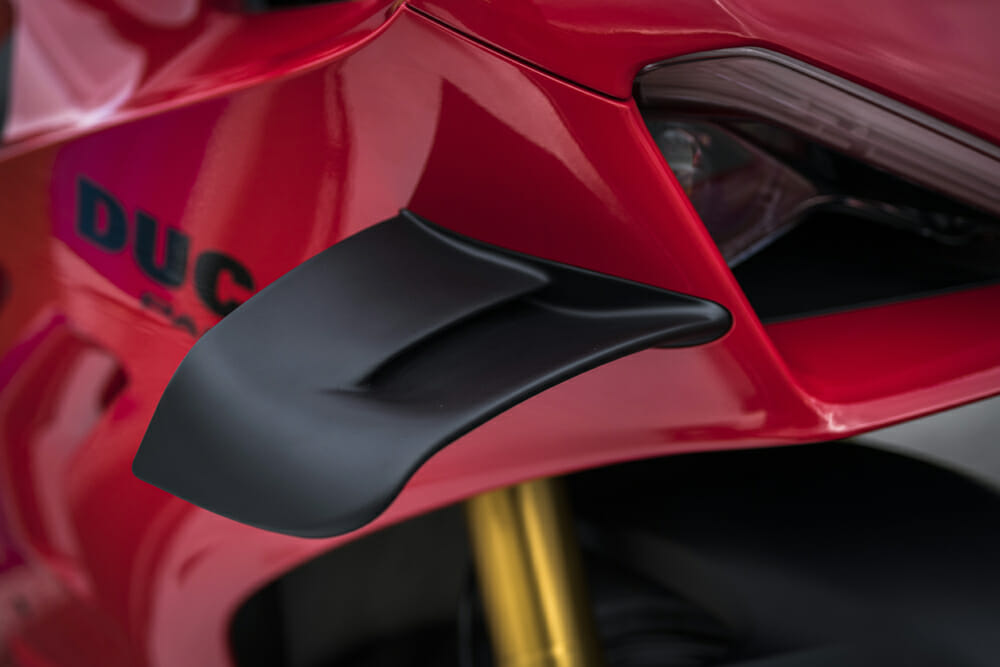
2022 Ducati Panigale V4 S Review | Captain Valia
The story from Ducati to go alongside this new flagship was an interesting one, delivered mainly by lead Ducati test rider Alessandro Valia at Jerez’s floating spaceship. Alessandro’s no punk, the dude is an absolute monster on a motorcycle and has signed off every Ducati production bike since 2007 and went to great lengths to explain how life in the warp-speed lane would be even faster if it was a more effortless place to be.
It all starts, he said, with the ergonomics. Narrowing the tank to give a more usable surface area to hang onto when you’ve got the thing on its ear, combined with a seat unit that’s had more depth and longitudinal room carved into it, should help with fatigue.

Next up, the steering needed to be even lighter and more telepathic, and the chassis needed to transfer less weight back and forth between throttle and brakes. That all makes sense to us, but the next-level thinking is that this isn’t just about being more comfy, it’s about affording riders more mental time and space to spend on better understanding the bike through the electronics mid-lap. The all-clever ones and zeros were what Alessandro really wanted to talk about.
Race mode on the old Panigale V4 S was not much more than a more aggressive throttle map, but now it’s an entirely new way of plugging your brain into the Panigale’s, and in Track EVO mode it’s all displayed via the dashboard.
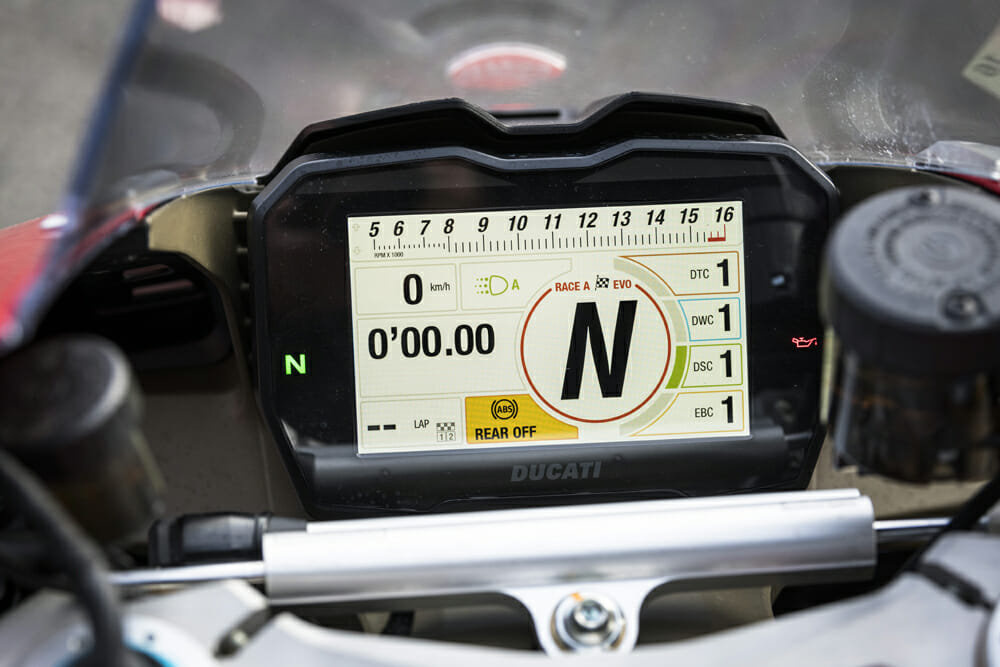
Whereas on the previous Panigale V4s (2018 and 2020) the electronic assistance was signaled by a single yellow flashing LED perched to the top left of the dash, which by the way could’ve been trying to tell you almost anything (TC, slide control, wheelie control) now it’s broken out into four separate displays and shown proud and center in high resolution. Light the TC up? The TC light will flicker. Wheelie control doing its thing? You’ll see that independently of TC, anti-wheelie, stability and engine braking. The revs are now just a thin bar up top, almost reminiscent of the 1199 and 1299, and there’re lap timers, max speeds and lap counts.
What this means is you can better understand how to adjust every facet of the electronics to suit what you’re asking of it by virtue of being able to understand exactly what’s going on. No more guesswork, and no other bike on showroom floors is doing this. It’s impressive stuff; it makes one wonder just how many years ago the GP bikes were doing this. Our guess? Probably not all that many.
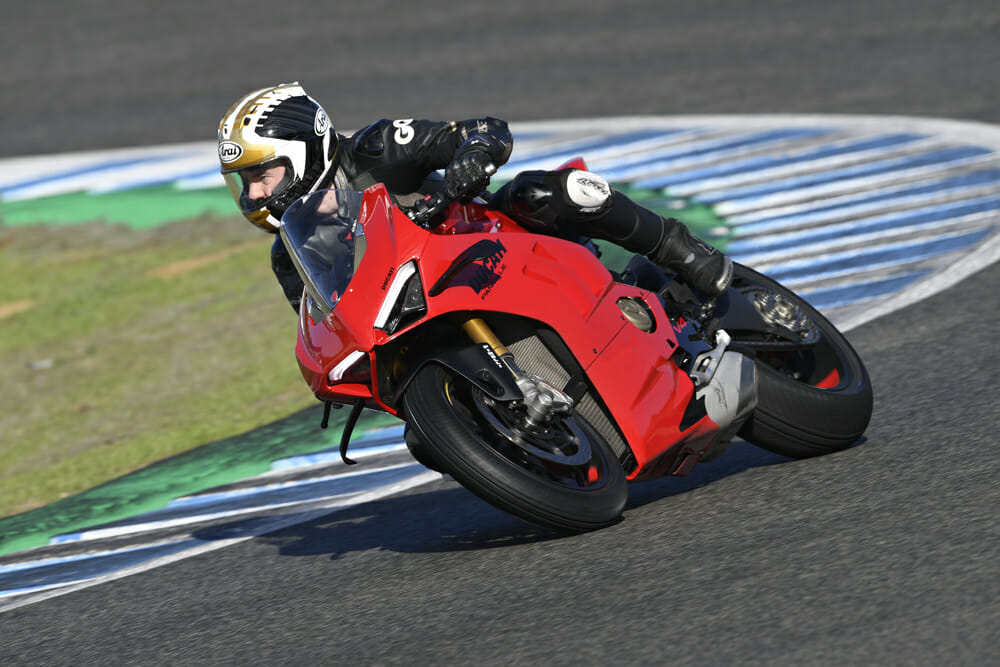
2022 Ducati Panigale V4 S Review | Rain? Rain??
Breakfast at the hotel next door to Jerez was augmented by the pitter-patter of rain on the roof. Ordinarily that would be a bad thing, but with a set of full wets on warmers, and electronics being the main thing to try to get one’s head around, it was anything but a bad thing: it was a proper test.
With just two laps under the belt around a patchy, greasy Jerez and its incredible corners, two things had already jumped out: the first was just how much smoother the quickshifter is than any of the previous models. And second, what a significant difference the revised gear ratios make. Now, counterintuitively for a V4, first gear is actually usable in places that aren’t called pitlane. You also get to hang onto gears much longer and really use the revs, of which the Desmo Stradale has a seemingly limitless supply. Bear in mind, this was a wet session, and other than a tiny pulse through the lever, there was not even the slightest hint that the electronics were keeping everything together, other than the fact that a raging V4 was “only” pumping out 150 horsepower in a wet throttle map.
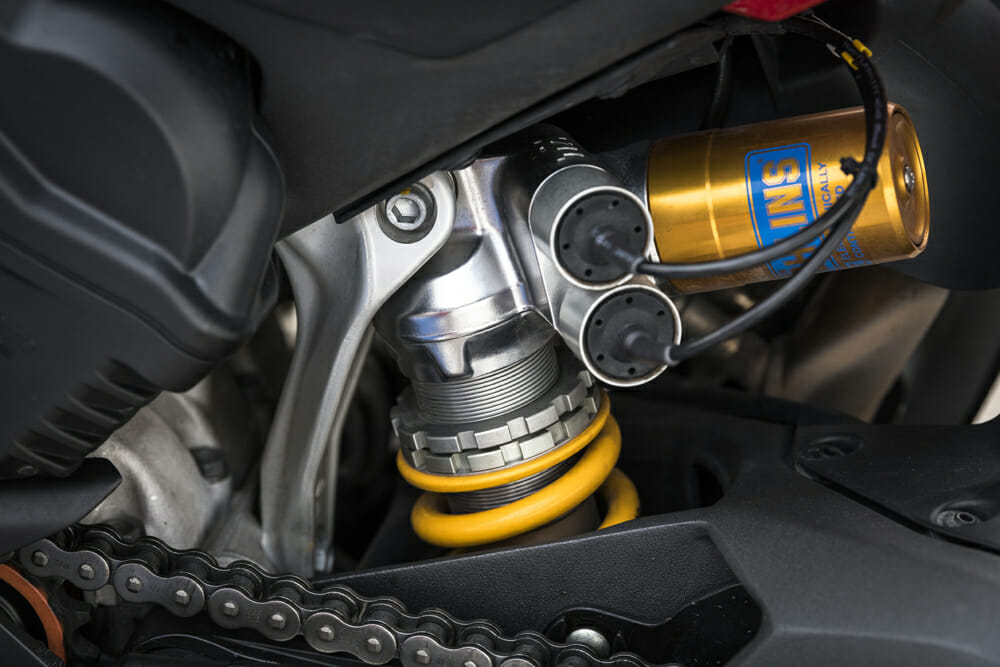
With two part wet, part drying sessions out of the way, and MotoGP hotshot Jorge Martin having dispatched us on the back wheel out of turn five, it was a case of just getting more and more stuck in and letting the track and the bike come to us. Words can barely describe how different this ’22 model is from the ’21 and ’20, let alone the ’18. Confidence and stability on the brakes is a night-and-day difference with far less movement from the rear tire, and we’ll put that down to the gas-charged forks and chassis tweaks. And speaking of movement, the signature Ducati power-weave is seemingly completely gone.
The steering also genuinely feels easier; a nudge of the bars, and it’ll more willingly follow any line you want, whereas the older models were slightly more of a negotiation. The changes to the tank, too, are absolutely welcome, and that’s saying something since the previous models were hardly short of surface to grip on to.
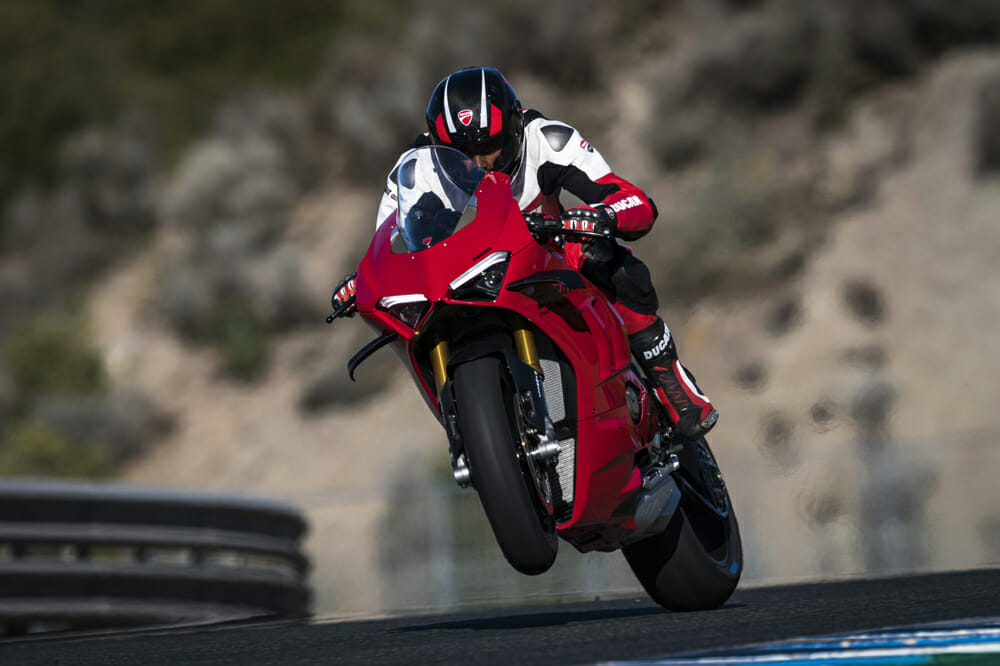
However, you’ll be hard pressed to notice the difference in the seat unit. The things to keep coming back to were just how much information you could take in from the race-mode dash, and that gearbox! The ratios are only changed in first, second and sixth, but it feels like all of them have been changed. And then you discover there’s a new “full power” mode which gives you everything the V4 will offer in second gear and above (first is still managed). Catch those corners if you can because they’ll be coming at you thick and fast. Additionally, for the first time ever, using the dynamic suspension mode seemed preferable to the fixed modes; something Jorge Martin admitted to over dinner.
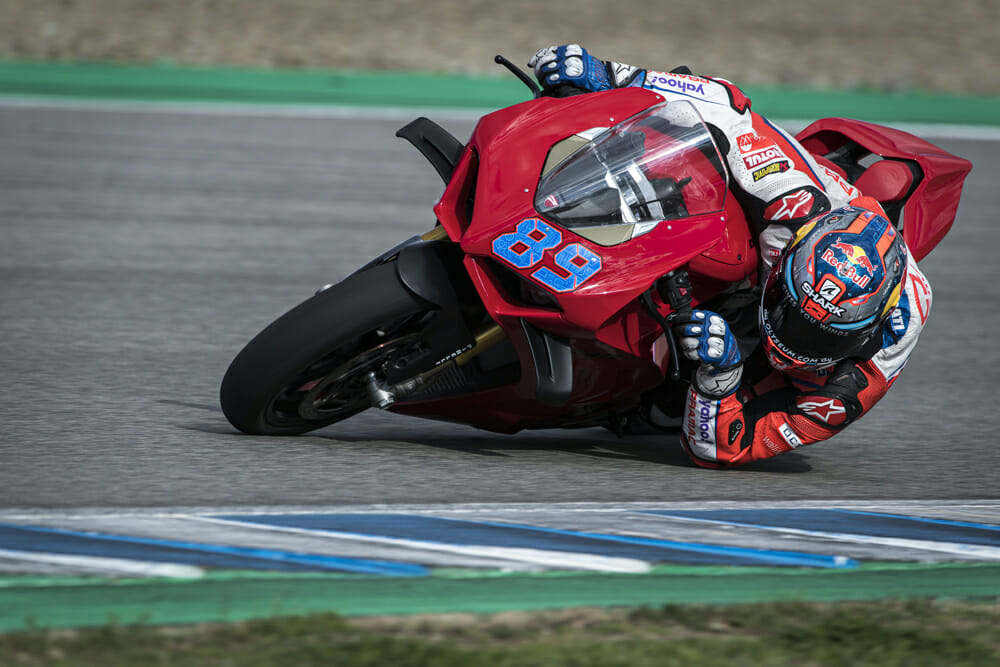
All this leaves us a few things to ponder over. This is the standard and S model, not the R, yet we’re talking an awful lot about its race and track enhancements—has this cost the Panigale V4 some road manners? It’s hard to say, but maybe it has. Ducati itself admits it’s a more track-oriented model, but does it matter? Perhaps not, since at most track days you’ll see more S models than R models.
The biggest question though, is have the changes actually worked? Is this a faster, easier machine to ride? Well, yes, it’s undeniably an easier thing to ride, but maybe in the same way that eight rounds with Tyson Fury are only marginally more bearable than nine. It’s still a full on, raucous, face-melting, head-banging animal of a thing, especially when you switch it into full power mode, so maybe you’ll still be faster on one of the other usual suspects. But you won’t get the experience, nor will you feel or look as good, and you won’t get that feeling that this is the very best thing a factory can throw at you. And that’s kind of the point, isn’t it? CN
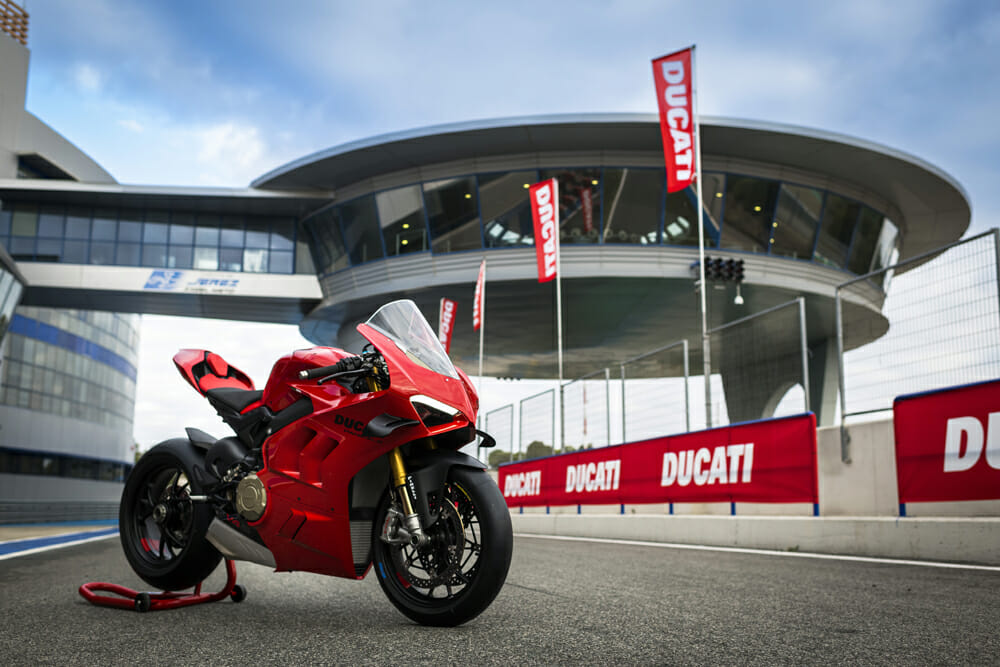
2022 Ducati Panigale V4 S Specifications
| MSRP: | $29,995 |
| Engine: | Desmosedici Stradale 90° V4, rearward-rotating crankshaft |
| Valvetrain: | 4 Desmodromically actuated valves per cylinder |
| Displacement: | 1103cc |
| Bore x stroke: | 81 x 53.5mm |
| Fuel injection: | Fuel injection: Electronic fuel injection system. Twin injectors per cylinder. Full ride-by- wire elliptical throttle bodies. Variable length intake system |
| Compression ratio: | 14.0:1 |
| Cooling system: | Liquid |
| Horsepower | (claimed): 210 hp at 12,500 rpm |
| Torque (claimed): | 90.6 lb-ft at 11,000 rpm |
| Exhaust: | 4-2-1-2 |
| Transmission: | 6-speed with Ducati Quick Shift (DQS) up/down EVO 2 |
| Clutch: | Hydraulically controlled slipper and self-servo wet multi-plate clutch |
| Electronics: | Ducati Traction Control (DTC) Engine Brake Control EVO (EBC EVO), Ducati Electronic Suspension EVO (DES EVO), Cornering ABS EVO, Ducati Wheelie Control EVO (DWC EVO), Ducati Slide Control (DSC) |
| Chassis: | Aluminum alloy front frame |
| Front suspension: | Öhlins NIX30 43mm fully adjustable pressurized fork with TiN treatment, electronic compression and rebound damping adjustment with Öhlins Smart EC 2.0 event-based mode |
| Rear suspension: | Fully adjustable Öhlins TTX36 unit, electronic compression and rebound damping adjustment with Öhlins Smart EC 2.0 event-based mode, aluminum single-sided swingarm |
| Front brake: | Dual 330mm semi-floating discs, radially mounted Brembo Monobloc Stylema (M4.30) 4-piston calipers with Bosch Cornering ABS EVO |
| Rear brake: | 245mm disc, 2-piston caliper with Bosch Cornering ABS EVO |
| Front tire: | Pirelli Diablo Supercorsa SP 120/70 ZR17 in. |
| Rear tire: | Pirelli Diablo Supercorsa SP 200/60 ZR17 in. |
| Rake: | 24.5° |
| Wheelbase: | 57.8 in. |
| Seat height: | 33.5 in. |
| Fuel capacity: | 4.5 gal |
| Weight (curb, claimed): | 431 lbs. |
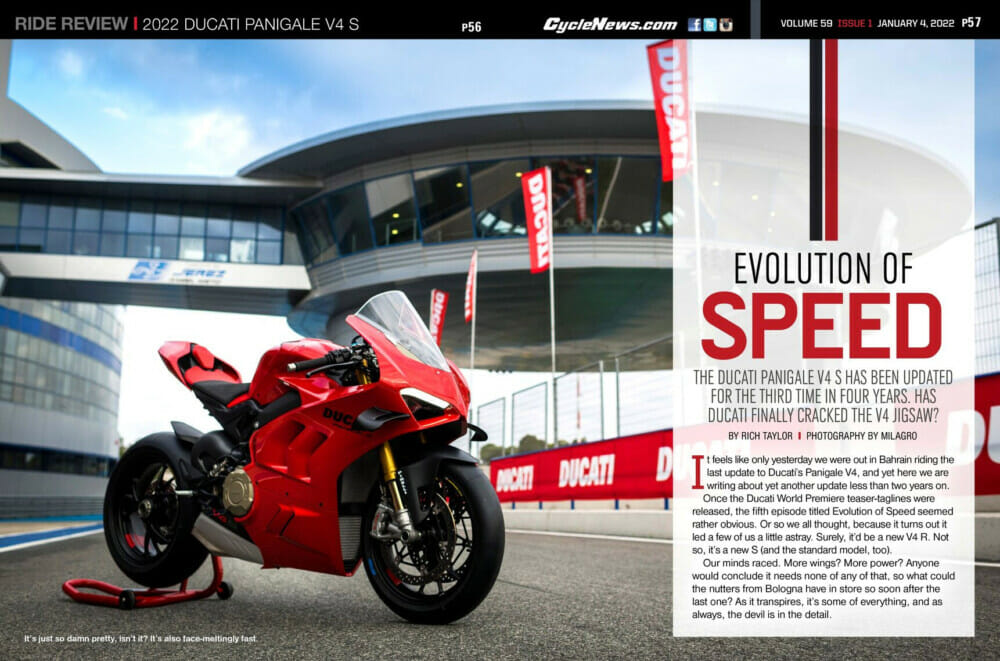
Click here to read the 2022 Ducati Panigale V4 S Review in the Cycle News Digital Edition Magazine.
Click here for the latest Cycle News Sportbike motorcycle reviews and news.
Click here for more Ducati motorcycle reviews and news.
